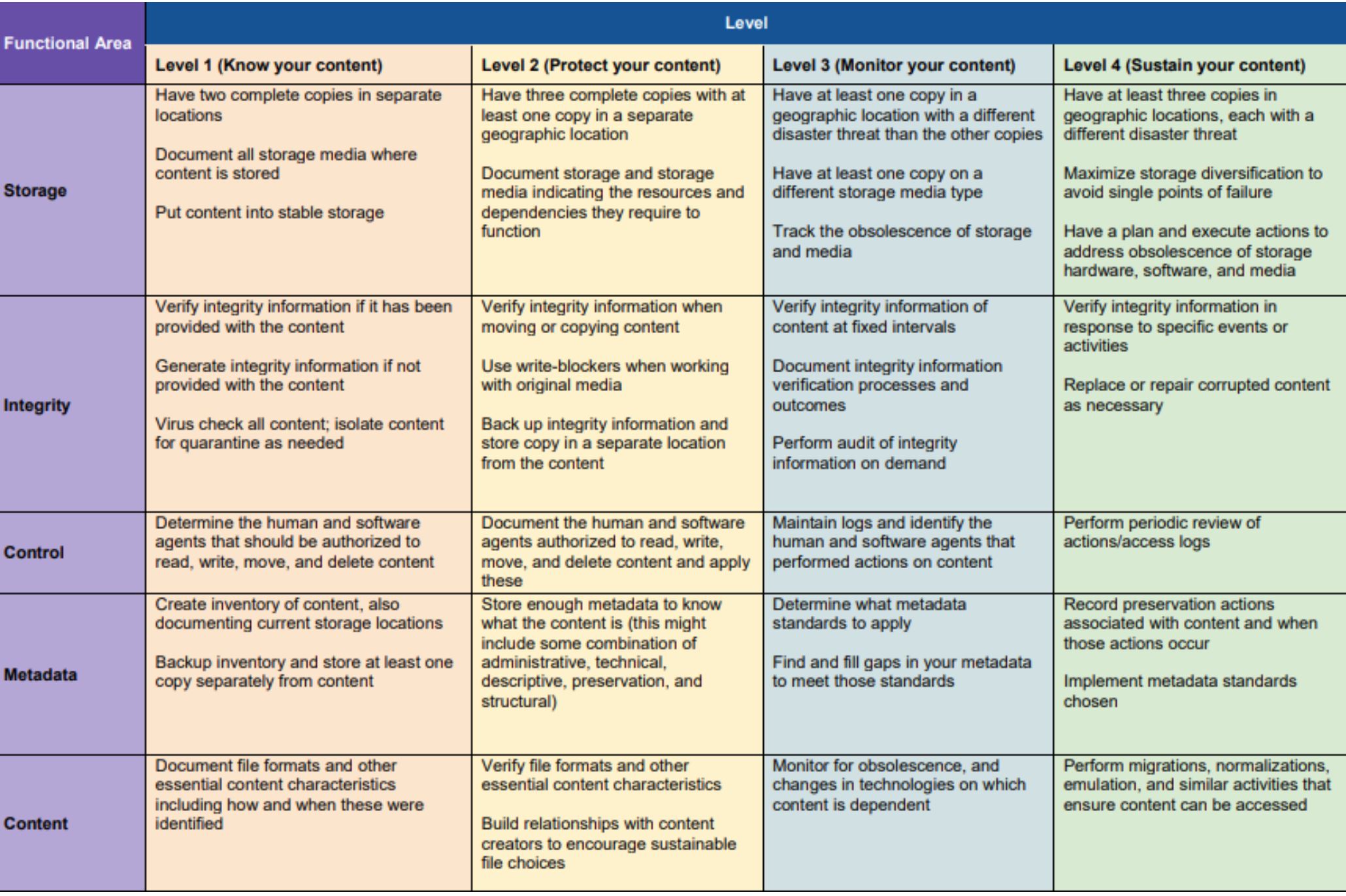Since August 2018 I have been involved in an ambitious international effort to revise the NDSA Levels of Preservation.
When I first joined the revision group I was working as a digital archivist at the Borthwick Institute for Archives.
I was a digital archivist who very much appreciated the NDSA Levels and had used them frequently to measure progress and to communicate with colleagues. The rumours that I had them printed out and pinned up above my desk are indeed true. I believe I was what you might call an NDSA Levels of Preservation ‘Super Fan’.
I joined the group because I had highlighted (for example in this blog post) some areas where I was unsure how to apply them or felt they could be subject to slightly different interpretation.
In November 2018 I moved to a new job as Head of Good Practice and Standards at the Digital Preservation Coalition. Clearly involvement in the NDSA Levels work was a good fit with this new role so I continued on…
It is great to have seen the public release of the new NDSA Levels of Preservation (and associated resources) last month so I thought this would be a good time to reflect on the work of the revision group as well as summarising some of the key changes that were made to the levels.
Version 2 of the (very colourful) NDSA Levels of Preservation
The revision working group first met in August 2018. Our meetings were carried out online as we were quite geographically dispersed. We worked in Google Drive – a great way of being able to collaborate on a document without worrying about creating conflicting versions.
After agreeing our draft charge in our first meeting we started off by discussing what we thought of the current levels of preservation, how we use them and what their strengths and weaknesses are.
The task of editing something that is so well used and highly thought of was quite a daunting one but we agreed a basic methodology, working through the grid systematically, one cell at a time and discussing any changes we felt should be made. We took into account feedback gatherered from the wider community (from a workshop at iPRES 2018, a session at DigiPres and later from the survey work carried out by the Implementation working group in parallel).
I laugh now when I note that in our first meeting we agreed to tackle 2 rows at a time. In reality the process was much slower. It actually took us 3 meetings to complete the revision of the first row!
Why did it take us so long? I guess there was lots of feedback to incorporate, lots of differing opinions across the group and lots of discussion around the exact wording of each element. Writing clear and concise statements that are not subject to multiple interpretations is quite a challenging task.
We wanted to ensure the language we used was consistent, actionable and widely applicable to anyone who wanted to apply the Levels. The fact that this was an international effort meant that we could battle out the differences between the meaning of terms in both US and UK English and hopefully resulted in wording that was clearer (also recognising that the group still represented a small geographic spread). It was agreed early on in our discussions that the new version of the levels would be accompanied by a glossary of terms or working definitions that would give further clarity.
We wanted to update the Levels in line with current good practice in digital preservation but ensure they were not so specific that they would rapidly go out of date. We had to maintain a balance between providing useful actionable guidance and being too prescriptive. In some areas of digital preservation there are more than one way of doing things and no single established path to implementing good practice.
So you may be wondering what has changed. The most noticeable difference perhaps is that they are now much more colourful! This revision will look much better stuck on your noticeboard than the last one! Below I highlight some of the other changes that were made but is by no means an exhaustive list.
Content not data
The original Levels used the word ‘data’ a lot. This is not a word that all digital archives use. Many do not consider the digital archives that they manage to be ‘data’ at all and assume that standards that refer only to data are not applicable to them. We decided that a more inclusive phrase would be ‘digital content’ or just ‘content’. This of course led to changes in the column headings, ‘Know your data’ being replaced with ‘Know your content’.
Tweaking the column headings
Some further changes were made to the column headings – we decided that at Level 4, ‘repair your content’ was better framed as ‘sustain your content’. For content to be repaired, there is an assumption that it is broken. Although digital preservation can be about repairing broken things, it is more often about sustaining content over time…trying to keep it unchanged whilst ensuring continued access.
The headings for levels 1 and 2, were swapped around, so at level 1 we now have ‘know your content’ and at level 2 ‘protect your content’. Though we could certainly see the logic behind the original order of these headings, the group felt that you have to know what you’ve got and where it is (get hold of it, put it somewhere safe, start to understand it) before you can really start to protect it.
The metadata row
One of the longest discussions the revision group had was about the metadata row of the levels. This is perhaps the row that has changed the most in version 2. I think it is fair to say that we found this one quite challenging to update. Perhaps this is because metadata is not necessarily implemented as a clear linear progression. Different organisations prioritise different types of metadata in different ways and there is no one agreed correct approach.
We also struggled a bit with the definitions of the different types of metadata (for example administrative, technical, transformative, preservation, rights metadata). Many of us had slightly differing understandings of what these terms mean and the fact that there is overlap between several of these categories just added to the confusion. The revised metadata row is quite a substantial rework of the original and hopefully more of an effective linear progression.
Moving away from file formats
There is no doubt that file formats are important to digital archivists and that identifying what you’ve got and encouraging use of open formats are useful activities. We decided however to make the last row of the NDSA Levels a bit broader, focusing not just on file formats but on digital content more generally. Again, we had lots of discussions about this row of the Levels. This potentially covers a huge range of preservation activities – all the things you might do to ensure your digital content can be accessed and understood in the future. We did not want to limit this to individual file migration-based activities but wanted to ensure other preservation strategies such as emulation were also included. We wanted the Levels to be equally applicable to complex types of content, for example, virtual reality, software, websites. For these types of content, it is helpful to move beyond working with individual files and consider the objects and their dependencies as a whole. We changed the title of this row from ‘File Formats’ to ‘Content’ and updated the whole row to reflect our thinking.
Short and snappy row headings
The group also had wider discussions about the current row headings and decided on a snappy single word heading for each of them.
Working definitions of terms
Alongside the revised NDSA Levels we have also created a set of working definitions (available as part of a longer document here). We agreed this was a priority from quite an early stage in the process. Whilst we wanted to keep the Levels short and snappy we were aware that this might not be enough and users may appreciate some additional explanation.
After many conference calls it is great to finally see our work released into the wild. Do dive in and take a look if you haven’t already.
We hope the revised NDSA Levels of Preservation will stand the community in good stead for the next few years to come. Perhaps this blog post will introduce the Levels to a new audience of potential 'Super Fans'. My wish is for this new revision be printed out and stuck on digital archivists noticeboards around the world!
I just wanted to end with a big thank you to the rest of the Revision Working Group and in particular to our ever patient chair Karen Cariani.

































































































































Comments
RSS feed for comments to this post